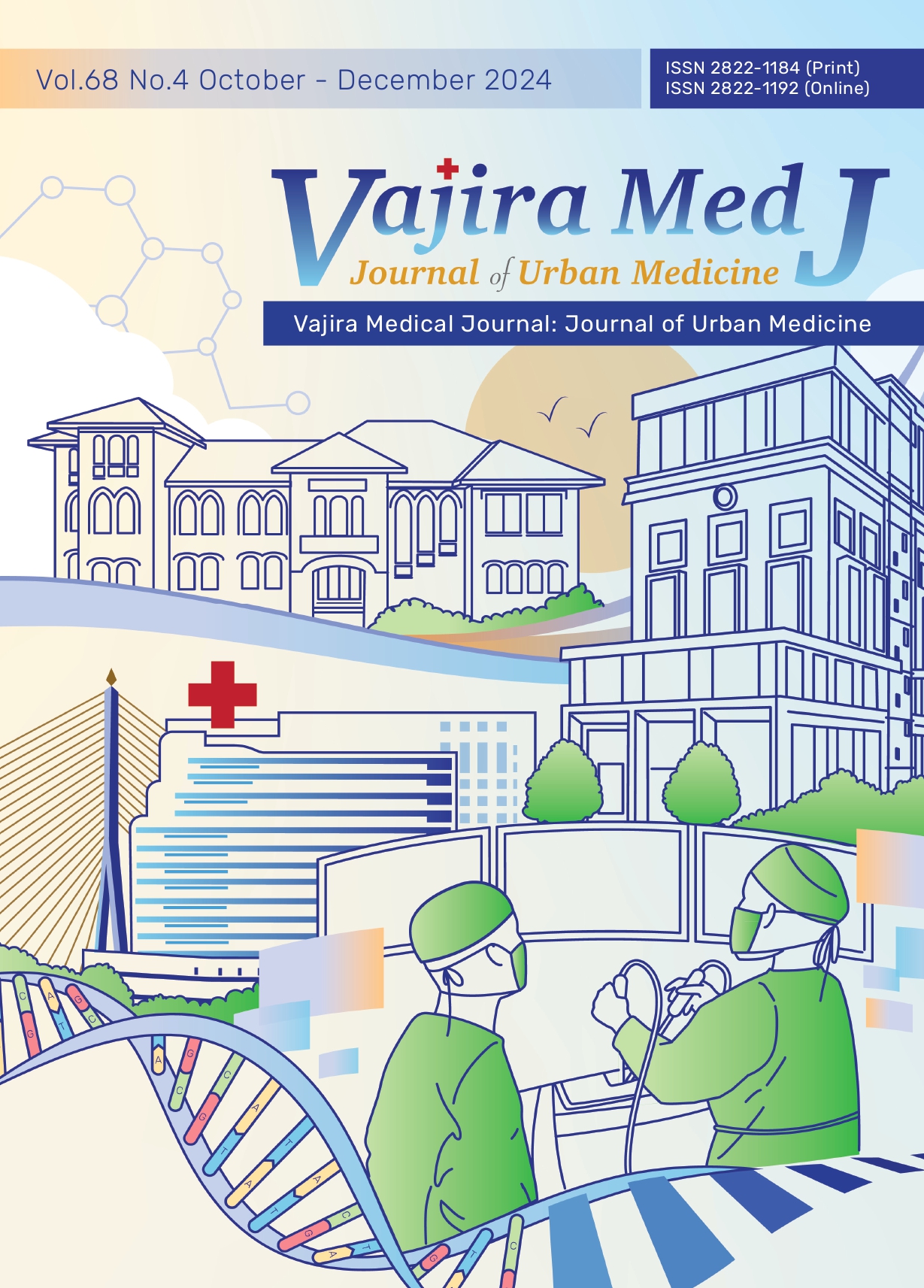The Prevalence of Postpartum Contraception Use among Teenage Mothers at Vajira Hospital, Thailand The Prevalence of Postpartum Contraception Use among Teenage Mothers
Main Article Content
Abstract
OBJECTIVES: To determine the prevalence of postpartum contraception use among teenage mothers and to identify the factors influencing both postpartum contraception use and loss to postpartum follow-up at the Faculty of Medicine Vajira Hospital in Thailand.
METHODS: Four hundred and seventy-five participants were randomly selected from 1,060 Thai teenage pregnant that gave birth at the Faculty of Medicine Vajira Hospital between 1 January 2017 and 31 December 2020 and were scheduled postpartum visits. The clinical factors associated with postpartum contraception use and loss to postpartum follow-up were studied using multiple logistic regression analysis.
RESULTS: A total of 451 participants remained after excluding criteria. Of these, 212 participants did not follow-up on their postpartum visits, leaving the limitation to summarize the true prevalence of postpartum contraception use of the total population. However, of the 232 participants who visited postpartum follow-ups, the prevalence of contraceptive use was 95.8%. Married status was the only factor associated with higher postpartum contraceptive use (odds ratio (OR) 12.81 [3.38-48.64]). Age 18 years and older (ORadj1.71 [1.16-2.53]), absence of previous contraceptive use (ORadj1.91 [1.29-2.80]), and total antenatal care visits fewer than 8 (ORadj 1.61 [1.07-2.42]) were significantly related with loss to postpartum follow-ups.
CONCLUSION: The prevalence of contraceptive use was high among teenage mothers who had follow-up postpartum visits. However, this population also had a high loss rate of postpartum visits. Interventions and close monitoring should be considered to evaluated further for effective adolescent reproductive services.
Downloads
Article Details

This work is licensed under a Creative Commons Attribution-NonCommercial-NoDerivatives 4.0 International License.
References
Siegel RS, Brandon AR. Adolescents, pregnancy, and mental health. J Pediatr Adolesc Gynecol 2014;27(3):138-50.
Ntshayintshayi PN, Sehularo LA, Mokgaola IO, Sepeng NV. Exploring the psychosocial challenges faced by pregnant teenagers in Ditsobotla subdistrict. Health SA 2022;27:1880.
Hillis SD, Anda RF, Dube SR, Felitti VJ, Marchbanks PA, Marks JS. The association between adverse childhood experiences and adolescent pregnancy, long-term psychosocial consequences, and fetal death. Pediatrics 2004;113(2):320-7.
Shaw M, Lawlor DA, Najman JM. Teenage children of teenage mothers: psychological, behavioural and health outcomes from an Australian prospective longitudinal study. Soc Sci Med 2006;62(10):2526-39.
World Health Organization. Adolescent pregnancy [internet]. 2024 [updated 2024 Apr 10; cited 2023 Sep 16]. Available from: https://www.who.int/news-room/fact-sheets/detail/adolescent-pregnancy
Sully EA, Biddlecom A, Darroch JE, Riley T, Ashford LS, Lince-Deroche N, et al. Adding it up: investing in sexual and reproductive health 2019 [internet]. 2020 [cited 2023 Sep 16]. Available from: https://www.guttmacher.org/report/adding-it-up-investing-in-sexualreproductive-health-2019
Population Division, Department of Economic and Social Affairs, United Nations. World population prospects 2022 [internet]. 2022 [updated 2022; cited 2023 Sep 16]. Available from: https://population.un.org/wpp/Download/Standard/Fertility
Department of Health. Reproductive health situation in adolescence 2022 [internet]. 2023 [updated 2023 Jul 25; cited 2023 Sep 16]. Available from: https://rh.anamai.moph.go.th/th/cms-of-1/214353
Aungsataporn S, Phaloprakarn C, Tangjitgamol S. Characteristics associated with loss to post-partum follow-up among adolescent mothers. J Obstet Gynaecol Res 2019;45(5):981-86.
Subcommittee of Professional Standard. RTCOG clinical practice guideline prenatal care [internet]. 2023 [updated 2023 Jan 20; cited 2023 Sep 16]. Available from: https://www.rtcog.or.th/content/viewid/276
World Health Organization. WHO recommendations on antenatal care for a positive pregnancy experience [internet]. 2016 [updated 2016 Nov 28; cited 2023 Sep 16]. Available from: https://www.who.int/publications/i/item/97892415499
American Academy of Pediatrics. Guidelines for perinatal care [internet]. 2017 [updated 2017; cited 2023 Sep 16 ]. Available from: https://www.acog.org/clinical-information/physician-faqs/-/media/3a22e153b67446a6b31fb051e469187c.ashx
Egbe TO, Omeichu A, Halle-Ekane GE, Tchente CN, Egbe EN, Oury JF. Prevalence and outcome of teenage hospital births at the Buea Health District, South West Region, Cameroon. Reprod Health 2015;12:118.
Narukhutrpichai P, Khrutmuang D, Chattrapiban T. The obstetrics and neonatal outcomes of teenage pregnancy in Naresuan University Hospital. J Med Assoc Thai 2016;99(4):361-7.
Nyarko SH. Prevalence and correlates of contraceptive use among female adolescents in Ghana. BMC Womens Health 2015;15:60.
Dee DL, Pazol K, Cox S, Smith RA, Bower K, Kapaya M, et al. Trends in repeat births and use of postpartum contraception among teens - United States, 2004-2015. MMWR Morb Mortal Wkly Rep 2017;66(16):422-6.
Muyama DL, Musaba MW, Opito R, Soita DJ, Wandabwa JN, Amongin D. Determinants of postpartum contraception use among teenage mothers in Eastern Uganda: a cross-sectional study. Open Access J Contracept 2020;11:187-95.
Anupma A, Sarkar A, Sharma P, Jindal S, Sharma JC. Status of contraceptive use for birth spacing after a teenage pregnancy: where do we stand? Cureus 2023;15(5):e38563.
Haider S, Stoffel C, Dude A. Adolescent contraception use after pregnancy, an opportunity for improvement. J Pediatr Adolesc Gynecol 2018;31(4):388-93.
Daniel WW. Biostatistics; a foundation for analysis in the health sciences. 6th ed. John Wiley&Sons; 1995.
Pitisuttutham P. Textbook of clinical research. 4th ed. Bangkok: Pimlak; 2018.
Maravilla JC, Betts KS, Couto E Cruz C, Alati R. Factors influencing repeated teenage pregnancy: a review and meta-analysis. Am J Obstet Gynecol 2017;217(5):527-45.
Rigsby DC, Macones GA, Driscoll DA. Risk factors for rapid repeat pregnancy among adolescent mothers: a review of the literature. J Pediatr Adolesc Gynecol 1998;11(3):115-26.
Huangthong M, Deoisres W, Suppaseemanon W. The factors related to rapid repeat pregnancy among teenage pregnant women. J Phrapokklao Nurs Coll 2019;30(1):161-72.
Nowik CM, Pudwell J, Smith GN. Evaluating the postpartum maternal health clinic: how patient characteristics predict follow-up. J Obstet Gynaecol Can 2016;38(10):930-5.
Wilcox A, Levi EE, Garrett JM. Predictors of non-attendance to the postpartum follow-up visit. Matern Child Health J 2016;20 Suppl 1:22-7.
DiBari JN, Yu SM, Chao SM, Lu MC. Use of postpartum care: predictors and barriers. J Pregnancy 2014;2014:530769.
Baldwin MK, Hart KD, Rodriguez MI. Predictors for follow-up among postpartum patients enrolled in a clinical trial. Contraception 2018;98(3):228-31.
Einav S, Tankel J. The unseen pandemic: treatment delays and loss to follow-up due to fear of COVID. J Anesth Analg Crit Care 2022;2(1):5.


